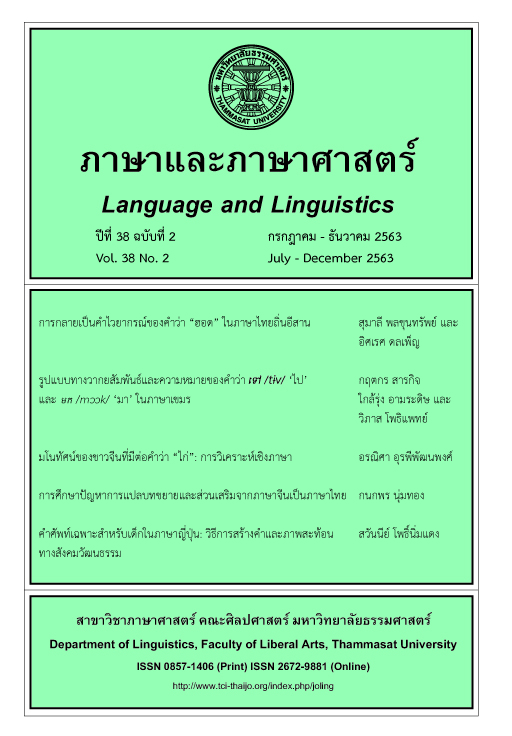The Syntactic Patterns and Meanings of ទៅ /tɨv/ ‘go’ and មក /mɔɔk/ ‘come’ in Khmer
Main Article Content
Abstract
The aim of this article is to investigate syntactic patterns and meanings of ទៅ /tɨv/ ‘go’ and មក /mɔɔk/ ‘come’ in Modern Khmer. The data were collected from two Khmer novels, published between 1938 and 2006. The findings show that ទៅ /tɨv/ ‘go’ and មក /mɔɔk/ ‘come’ in Khmer appear in verb phrases and prepositional phrases. There are various meanings, depending on their position in sentences. When they occur in sentences, they indicate physical movement, abstract movement, direction of movement, direction of communication, direction of looking, changing and disappearance, relation in time, and relation in quantity.
Article Details
บทความทุกบทความเป็นลิขสิทธิ์ของภาษาและภาษาศาสตร์
References
กรองกานต์ รอดพันธ์. (2555). “ถึง”: การศึกษาเชิงประวัติ (วิทยานิพนธ์ปริญญามหาบัณฑิต). จุฬาลงกรณ์มหาวิทยาลัย, กรุงเทพฯ.
กิ่งกาญจน์ เทพกาญจนา. (2553). หน่วยสร้างกริยาเรียงต้นแบบในภาษาไทย. ใน อมรา ประสิทธิ์รัฐสินธุ์ (บ.ก.), หน่วยสร้างที่มีข้อขัดแย้งในไวยากรณ์ไทย: หน่วยสร้าง คุณานุประโยค หน่วยสร้างประโยคเติมเต็ม หน่วยสร้างกริยาเรียง และหน่วยสร้าง กรรมวาจก (พิมพ์ครั้งที่ 2). กรุงเทพฯ: โรงพิมพ์แห่งจุฬาลงกรณ์มหาวิทยาลัย.
กิ่งกาญจน์ เทพกาญจนา. (2559). Grammaticalization กระบวนการกลายเป็นรูป ไวยากรณ์. กรุงเทพฯ: โครงการเผยแพร่ผลงานวิชาการฝ่ายวิจัย คณะอักษรศาสตร์ จุฬาลงกรณ์มหาวิทยาลัย.
จินดา เฮงสมบูรณ์. (2528). คำกริยาบอกการเคลื่อนที่ในภาษาไทย (วิทยานิพนธ์ปริญญามหาบัณฑิต). จุฬาลงกรณ์มหาวิทยาลัย, กรุงเทพฯ.
ชาฎินี มณีนาวาชัย. (2551). การศึกษาสมมูลภาพในการแปลคำกริยา “ไป” และ “มา” ในภาษาไทยเป็นภาษาเยอรมันในงานวรรณกรรมนวนิยายแปล (วิทยานิพนธ์ปริญญามหาบัณฑิต). จุฬาลงกรณ์มหาวิทยาลัย, กรุงเทพฯ.
ธีระพันธ์ เหลืองทองคำ. (2557). ความหลากหลายและความหลอมรวมทางภาษาในประเทศ กลุ่มประชาคมอาเซียน. วารสารเอเชียปริทัศน์, 35(1), 1-28.
พ. นววรรณ (นามแฝง). (2527). การใช้ภาษา 2 (พิมพ์ครั้งที่ 4). กรุงเทพฯ: พลพันธ์การพิมพ์.
ราชบัณฑิตยสภา. (2560). พจนานุกรมศัพท์ภาษาศาสตร์ (ภาษาศาสตร์ทั่วไป) ฉบับราชบัณฑิตยสภา. กรุงเทพฯ: เอบิช อินเตอร์กรุ๊ป.
อรวรรณ บุญยฤทธิ์. (2562). ระบบเสียงและไวยากรณ์ภาษาไทยและภาษาเขมร. กรุงเทพฯ: ภาควิชาภาษาตะวันออก คณะโบราณคดี มหาวิทยาลัยศิลปากร.
อุไรศรี วรศะริน. (2553). ร่องรอยภาษาเขมรในภาษาไทย Les elements khmers dans la formation de la langue siamoise (อรวรรณ บุญยฤทธิ์, จตุพร โคตรกนก และสมเกียรติ วัฒนาพงษากุล, ผู้แปล). กรุงเทพฯ: ภาควิชาภาษาตะวันออก คณะโบราณคดี มหาวิทยาลัยศิลปากร วังท่าพระ. (ต้นฉบับพิมพ์ ปี พ.ศ. 2527).
Aikhenvald, A. Y. & Dixon, R. M. W. (2006). Serial verb constructions: A cross-linguistic typology. Oxford, England: Oxford University Press.
Bisang, W. (2015). Modern Khmer. in M. Jenny & P. Sidwell (Eds.), The handbook of Austroasiatic languages (pp. 677-716). Leiden, the Netherlands: Printforce.60
Clark, M. (1992). Serialization in mainland Southeast Asia. Proceedings of the 3rd International Symposium on Language and Linguistics (pp. 145-160). Bangkok, Thailand: Chulalongkorn University.
Haiman, J. (2011). Cambodian: Khmer. Amsterdam, the Netherlands: John Benjamins.
Headley, R. K., Chim, R., & Soeum, O. (1997). Modern Cambodian-English dictionary. Kensington, MD: Dunwoody Press.
Rangkupan, S. (1992). Subsidiary verbs /pay/ “go” and /maa/ “come” in Thai (Unpublished master’s thesis). Chulalongkorn University, Bangkok, Thailand.
គង្គ ប៊ុនឈឿន. (2006). មេឃចុះអ័ប្ប. ភ្នំពេញ: បណ្ណាល័យឆពណ្ណរង្សី.
ឃឹន សុខ. (2007). វេយ្យាករណ៍ភាសាខ្មែរ. ភ្នំពេញ: រោងពុម្ពមិត្តភាពកម្ពុជា.
រីម គីន. (1965). សូផាត. (បោះពុម្ពលើកទី 12). ភ្នំពេញ: គ្រឺះស្ថានបោះពុម្ពនិងចែកផ្សាយនៃ ក្រសួងអប់រំ យុវជន និងកីឡា.


